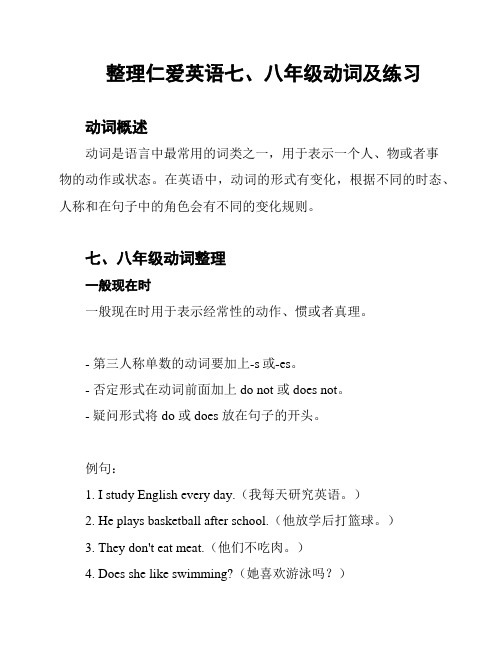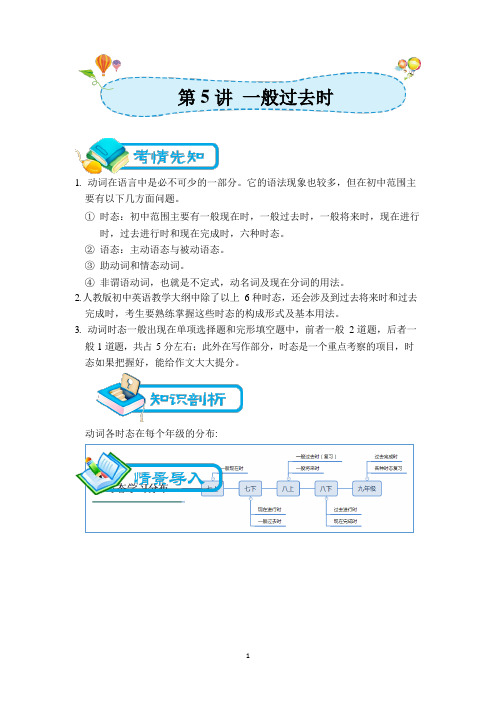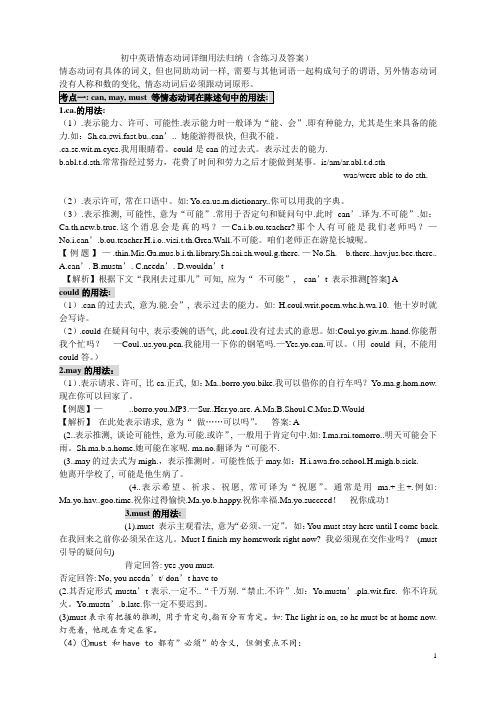初中英语动词讲解及重点学习的练习.doc
系动词讲解与练习-初中英语

系动词讲解与练习-初中英语(学生)(总3页)--本页仅作为文档封面,使用时请直接删除即可----内页可以根据需求调整合适字体及大小--Linking Verb系动词(Link Verb),它本身有词义,但不能单独用作谓语,不能用进行时态,后边必须跟表语(adj)即:link v + adj,构成系表结构说明主语的状况、性质、特征等情况。
(1)be 动词We are good friends.The earth is as round as a ball.(2)感官系动词: feel, smell, sound,Your idea sounds great.The flowers smell sweet and nice.The pizza made by Lucy tastes delicious.Ice always feels cold to us.(3)变化系动词: become, grow, turn, fall, get, goThe days become longer and longer in summer.Her face turned red when the teacher called her name.The child fell asleep while he doing his homework.Everything will come all right in the end.(4) 表像系动词: seem, appear, look, “看起来、显得”seem/ appear+(to be ) adj/nShe seemed (to be) an honest woman.He seemed (to be) interested in the book .He looked(看起来) angry/ sad/ happy.He appeared (to be) disappointed.(5) 持续系动词:keep, hold, remain, stay, 表示状态、情况等的继续或保持。
初中英语动词知识点总结、例句及练习题

初中英语动词知识点总结、例句及练习题动词类型动词是英语中最基本的词类之一,表示动作、状态、行为等。
根据动词的不同特点,可以将其分为以下几种类型:1. 及物动词:需要接宾语来完成意义的动词。
例:throw (扔),“He throws a ball.” (他扔一个球。
)throw (扔),“He throws a ball.” (他扔一个球。
)2. 不及物动词:不需要接宾语的动词。
例:run (跑),“The dog is running.” (那只狗在跑。
)run (跑),“The dog is running.” (那只狗在跑。
)3. 连系动词:用来表示主语的状态、特征或性质的动词。
例:be (是),“She is smart.” (她很聪明。
)be (是),“She is smart.” (她很聪明。
)动词时态动词的时态表示动作或状态发生的时间。
以下是常见的动词时态:1. 一般现在时:表示经常性的动作或现实存在的状态。
例:play (玩),“I play soccer every Sunday.” (我每个星期天踢足球。
)play (玩),“I play soccer every Sunday.” (我每个星期天踢足球。
)2. 一般过去时:表示过去某个时间发生的动作或状态。
例:watch (看),“She watched a movie last night.” (她昨晚看了一场电影。
)watch (看),“She watched a movie last night.” (她昨晚看了一场电影。
)3. 现在进行时:表示正在进行的动作。
例:study (研究),“They are studying for exams.” (他们正在为考试复。
)study (学习),“They are studying for exams.” (他们正在为考试复习。
)动词的形式动词可以根据不同的时态和语态变化形式。
整理仁爱英语七、八年级动词及练习

整理仁爱英语七、八年级动词及练习动词概述动词是语言中最常用的词类之一,用于表示一个人、物或者事物的动作或状态。
在英语中,动词的形式有变化,根据不同的时态、人称和在句子中的角色会有不同的变化规则。
七、八年级动词整理一般现在时一般现在时用于表示经常性的动作、惯或者真理。
- 第三人称单数的动词要加上-s或-es。
- 否定形式在动词前面加上 do not 或 does not。
- 疑问形式将 do 或 does 放在句子的开头。
例句:1. I study English every day.(我每天研究英语。
)2. He plays basketball after school.(他放学后打篮球。
)3. They don't eat meat.(他们不吃肉。
)4. Does she like swimming?(她喜欢游泳吗?)现在进行时现在进行时用于表示现在进行的动作或情况。
- 动词用-ing 结尾。
- 现在进行时由助动词 be 和动词的现在分词构成。
例句:1. She is reading a book now.(她正在看书。
)2. They are playing soccer in the park.(他们正在公园里踢足球。
)一般过去时一般过去时用于表示过去某个时间发生的动作或情况。
- 动词过去式的构成有规律和不规律两种。
- 一般过去时由动词的过去式构成。
例句:1. I watched a movie last night.(昨晚我看了一场电影。
)2. She studied English when she was in high school.(她上高中时研究英语。
)过去进行时过去进行时用于表示过去某个时间正在进行的动作或情况。
- 动词用-ing 结尾。
- 过去进行时由助动词 was/were 和动词的现在分词构成。
例句:1. They were playing games at that time.(那个时候他们正在玩游戏。
(版)初中英语常见动词短语汇总及练习题(附解析)

初中英语高频考点之动词短语及习题(附解析) 一.同一动词+不同介词/副词break 短语breakin打断;闯入breakinto 破门而入breakout 爆发breakup打碎;结束;解散breakdown 发生故障;抛锚,分解breakaway脱离,放弃come短语comeup升起;发生comeupwith 想出〔主意〕comeacross(偶然)遇见(或发现)comealong进展;一起去comedown下降;下落comein进来comefrom来自comeback回来comeon赶快;加油comeout出版,发行;出现;开花;发芽comeover过来;顺便来访cometrue(希望、梦想等),成cut短cutup切碎cutdown 砍到,消减cutoff 切断,切除cutout 除;去;剪下cutin插嘴fall短fallinto 落入;陷入fallbehind 落后falldown 摔倒,倒塌falloff(从⋯⋯上)掉下fallasleep入睡fallover 倒;跌倒get短getaway逃离getback返回getdown下降geton上getoff下getover克服getup起床;起来getalong/onwithsb. 与某人相处go短语goaway走开;离开goback回去goup上升;增长goout出去;熄灭gooff〔闹钟〕发出响声goover仔细检查;复习gothrough通过give短语giveaway赠送;分发giveback还给;归还;恢复(健康等)givein投降,屈服giveout发出(气味、光线、声音、信号);分发giveup放弃jump短语jumpinto 跳入jumpover 跳过jumpoff 跳离leave短语leavefor出前往;身去leavebehind留下;留leaveout漏;省去;不考leavealone不打;不理look短lookafter 照;照看lookat看lookaround 四周lookfor找;求lookintolookout留神lookover(仔)lookthroughlookup(在典、参考等中);找lookupto佩;仰慕;尊敬lookdownupon瞧不起lookforwardto 盼望;期待put短putaway把⋯⋯收起来;存⋯⋯用putdown写下;放下putoff推;拖延puton穿上;上演;增加putout扑灭;熄灭(火);伸出putup张贴;搭建putback放回原处;把〔钟〕拨慢take短语takeaway拿走;带走takedown取下;记下;拆卸takein吸入;吞入(体内)takeout取出takeoff脱下〔衣服〕;〔飞机等〕起飞takeup占据(时间、空间);开始从事;拿起takecare留神;小心takeafter(在外貌、性格等方面)与(父母等)相像takecareof照看;照顾turn短语turndown调低;拒绝turnup 调高;出现turnon翻开;接通turnoff 关闭;切断turnout结果是turnin上交send短语sendout发出,发送,派遣sendup 发射sendfor 派人去请sendin寄去,递交二.不同动词+同一介词/副词about短语careabout关心;在意hearabout 〔=hearof〕听说talkabout谈论;讨论;thinkabout考虑;认为throwabout 乱丢;抛撒worryabout担忧at短语pointat 指向lookat看〔某人〕throwat 投向;掷向laughat(sb.)嘲笑〔某人〕knockat敲shoutat〔sb.)对〔某人〕大喊aimat瞄准;旨在away短getaway逃离giveaway送;分putaway把⋯⋯收起来;存⋯⋯用runaway逃跑;跑掉takeaway拿走throwaway扔掉moveaway搬走,移开back短bringback恢复;使想起;comeback回来getback回来;恢复giveback;送回goback回去talkback回嘴;嘴payback (借款等)down短breakdown 停止运;出故障calmdown保持冷静cutdown砍倒;削减falldown 落下;摔倒getdown下来;落下putdown 写下;下;放下shutdown 关上;停shootdown 射下,落takedown 撤除;turndown低;关小;拒writedown写下;下in短believein信任;信bringin引;生checkin到;登comein来handin交上;提交;呈送takein吸入;吞入(体内);理解;欺joinin 参加,参加of短hearof听thinkof 想起;;考getoutof 离开;从⋯⋯出来takecareof照;照看off短breakoff突然中止;中断cutoff切除;切断dropoff 减少;下降falloff从⋯⋯掉下getoff脱下;下gooff( )出响声;出〔光、等〕keepoff勿踏;勿knockoff停止做某事payoff清(欠款等)putoff推;拖延runoff 跑掉;迅速离开seeoff〔某人〕送行setoff身〔去某地〕;起程sendoff派遣shutoff关;停止运takeoff脱下〔衣服〕,〔机等〕起telloff ;分派turnoff 关on短puton穿上turnon翻开fighton持passonkeepon〔行〕tryon穿;看workon从事;忙于dependon依comeon赶快;加油;来吧holdon等一等〔挂〕out短blowout 吹breakout(争、火灾等)突然生;爆bringout 使;使表出checkout看;察cleanout去除;把⋯⋯打干clearout 清理;掉comeout出版;表cutout 除;去findout明;弄清getout出去,离开giveout出(气味、光、声音、信号);分goout出去;熄handout分发;发放hangout闲逛keepout不让......进入leaveout不包括;不提及;忽略lookout留神;留神putout扑灭;熄灭(火)pointout 指出runout 用尽;耗尽sellout卖完;售光setout出发;启程standout 站出来;突出;坚持到底takeout取出workout算出;解决help(sb.)out帮助(某人)解决困难over短语comeover过来;顺便来访fallover 绊倒;跌倒getover克服;恢复;原谅goover仔细检查;复习lookover(仔细)检查thinkover 仔细考虑up短bringup教育;培养;提出cheerup使振;使高起来(cheersb.up) cleanup(把⋯⋯)打干;(把⋯⋯)收拾整cutup切碎dressup穿上盛装;装扮eatup吃光;吃完fixup修理;修getup起床giveup放弃growup成;大hangup挂断hurryup赶快lookup(在典、参考等中);找makeup造;形成;成pickup起;接putup;搭建ringup打sendup射,把⋯⋯送上去setup建立;立;开showup出席;露面stayup不睡;熬夜takeup(尤指消遣)学着做;开始做thinkup想出turnup开大(声音);出useup用完;用光;耗尽wakeup醒来with短agreewith同;持相同意beginwith以⋯⋯开始connectwith与⋯⋯相dealwith理;付catchupwith 赶上comeupwith提出;想出(主意、答复等) getalong/onwithsb. 与某人相goonwithkeepintouchwithsb.与某人保持系keepupwith与......并;跟上习题及解析1.Wewillnever_______ourdreamuntilitcomestrueoneday.A.giveupB.giveinC.giveoutD.giveawayA【解析】句意:我们永远不会_ ____我们的梦想直到它实现的那一天。
初中英语知识点总结及练习

初中英语知识点总结及练习一、词汇学习1. 基础词汇积累- 每天记忆一定数量的单词,如20个,并复习前一天的单词。
- 使用词汇卡片或应用程序辅助记忆。
- 通过阅读英语文章和观看英语视频增加词汇量。
2. 词性转换- 掌握名词、动词、形容词、副词等基本词性的转换规则。
- 练习将动词转换为现在分词、过去式、过去分词等。
- 学习形容词和副词的比较级和最高级形式。
3. 短语搭配- 学习并记忆常见的动词短语和介词短语。
- 通过例句理解短语搭配的含义和用法。
- 练习在句子中正确使用短语搭配。
二、语法知识1. 时态- 掌握一般现在时、一般过去时、一般将来时等基本时态。
- 学习现在进行时、过去进行时、将来进行时等进行时态。
- 了解并练习使用现在完成时和过去完成时。
2. 语态- 理解主动语态和被动语态的区别。
- 学习如何将主动语态转换为被动语态。
- 练习在不同情境下使用适当的语态。
3. 句型结构- 学习简单句、并列句和复合句的构成。
- 掌握定语从句、状语从句等从句的使用。
- 练习使用条件句和虚拟语气。
三、听力训练1. 听力材料选择- 选择适合初中生水平的听力材料,如英语教材、儿童故事、简短新闻等。
- 每天安排一定时间进行听力练习。
2. 听力技巧- 学习预测、捕捉关键信息和理解上下文的技巧。
- 练习在听的过程中做笔记,以帮助理解和记忆。
3. 听力题型练习- 熟悉常见的听力题型,如选择题、填空题、判断题等。
- 通过模拟练习提高解题速度和准确率。
四、阅读理解1. 阅读材料选择- 阅读适合初中生的英语文章,包括故事、科普文章、短篇新闻等。
- 逐步增加阅读材料的难度和篇幅。
2. 阅读技巧- 学习快速阅读和精读的技巧。
- 练习通过上下文推断生词的意思。
- 培养批判性阅读的能力,理解作者的观点和意图。
3. 阅读题型练习- 熟悉阅读理解题的题型,如主旨大意题、细节理解题、推理判断题等。
- 练习在限定时间内完成阅读和答题。
五、写作技巧1. 文章结构- 学习如何组织文章,包括引言、正文和结尾。
初中英语语法专项复习英语动词时态和语态讲解和练习题

初中英语语法专项复习:英语各个时态和语态讲解及练习题初中英语有16种时态,但是常用的只有9种:一般现在时、一般过去时、一般将来时、现在进行时、过去进行时、现在完成时、过去完成时、过去将来时、现在完成进行时;下面分别介绍;1、一般现在时的用法1 一般现在时表示经常性、习惯性的动作;表示现在的状态、特征和真理;句中常用always,usually,often,sometimes,seldom,rarely,never,every daymorning,Monday,week,...etc.,every there years,once a weekday,month,...etc.,...等时间状语;例如:a. He goes to school every day.b. He is very happy.earth moves around the sun.2 在时间状语从句和条件状语从句中,用一般现在时表示将来;例如:a. If you come this afternoon, we’ll have a meeting.b. When I graduate, I’ll go to countryside.2.一般过去时的用法1 表示过去某时间发生的事、存在的状态或过反复发生的动作;常和:last weeknight,Monday,month,year,...etc.four years agodays,month,...etc.before1980three,liberation,从句,...etc.the day before yesterday,the day before last,the year before last,just now,a monent ago,yesterday,yesterday morning,this morning,at first,at last,in the end,finally,then,..a. He saw Mr. Wang yesterday.b. He worked in a factory in 1986.2表示过去经常发生的动作, 也可用“used to “ 和“would + 动词原形”; I used to smoke. During the vacation I wouldm in the sea.注:”used to “ 表示过去常发生而现在不再发生的动作或存在的状态;a. I am used to the climate here.b. He is used tomming in winter.3.一般将来时的用法一般将来时表示将来的动作或状态;其表达形式除了“ will 或shall + 动词原形”表示即将发生的或最近打算进行的事;常和:next weekMonday,month,year,...etc.in three daysan hour,...etc.tomorrow,tomorrow morning,the day after tomorrow,the day after next,the year after next,tonight,in 20102016...etc.this evening,this Saturday,after Wednesday,soon,sometime next week,one day in futuer,sooner or later,...1be going to do 结构It is going to rain.We are going to have a meeting today.2 “be about to + 动词原形” 表示即将发生的动作,意为be ready to do sth. 后面一般不跟时间状语; We are about to leave.3 go , come , start, move, leave, arrive ,stay 等可用进行时态表示按计划即将发生的动作;I’m leaving for Beijing.4.现在进行时的用法1 现在进行时表示现在正在进行的动作,由“ be + 现在分词” 构成;常和:now,these daysweeks,months,...etc. this monthweek,...etc.Look,Listen,...另外, “系动词+ 介词或副词” 也表示进行时的意义;What are you doingThe bridge is under construction.2 表示感觉、愿望和状态的某些动词如have, be , here, se, like 等一般不用进行;5.过去进行时的用法1 过去进行时过去某一时刻、某一阶段正进行的动作,由“ was were + 现在分词”构成;常和:this time yesterday,this time last Friday,in those days,at nine last night,from one to three yesterday afternoon,...In 1980 he was studying in a university.He was reading a novel when I came in.6.现在完成时的用法现在完成时由“have/has + 过去分词.其使用有两种情况:1 现在完成时所表示的动作在说话之前已完成,但对现在有影响;句中没有具体时间状语;常和:just,alreadly,yet,never,ever,now,before,this week,today,these days,once,twice,three times,...He has gone to Fuzhou.He has been to Fuzhou.2 现在完成时所表示的动作开始于过去,持续到现在,也许还会持续下去常用for 和since表示一段时间的状语或since then1949,last Monday,two o'clock,从句...,etc.,ever since then,for three daysa long time,two hours,...etc.so far , now, today, this wek month, year 等表示包括现在内的状语;He has studied English for 5 years.He has studied English since 1985.Now I have finished the work..注意:表示短暂时间动作的词如come, go , die, marry, buy 等的完成时不能与for, since 等表示一般时间的词连用;正确:I have bought the book already.错误:I have bought the book for two years.改:I have had the bookl for two years.7.过去完成时的用法1 过去完成时由“had + 过去分词”构成;过去完成时的动作表示过去某一时刻或某一时刻或某一动作之前完成的动作或状态;句中常用by then1977,yesterday,eight last night,the time we got there,...etc.by the end of last termweek,year,month,...etc..by, before, until, when 等词引导的时间状语;By the end of last year we had built five new houses.I had learnt 5000 words before I entered the university.2过去完成时的动词还可表示过去某一时刻之前发生的动作或状态持续到过去某个时间或持续下去;Before he slept, he had worked for 12 hours.8.过去将来时的用法过去将来时表示从过去的某个时间看来将要发生的动作或存在的状态;过去将来时由“should 或would + 动词原形” 构成;第一人称用should, 其他人称用would. ;常和:They were sure that they would succeed.二动词语态1.当句子的主语是动作的执行者时, 谓语的形式叫主动语态;句子的主语是动作承受者时,谓语的形式叫被动作语态;被动语态由助动词be + 过去分词构成,时态通过be 表现出来;1 一般现在时:You are required to do this.2 一般过去时:The story was told by her.3 一般将来时:The problem will be discussed tomorrow.4 现在进行时:The road is being widened.5 过去进行时:The new tool was being made.6 现在完成时:The novel has been read.7 过去完成时:He said that the work had been finished.8 过去将来时:He said that the trees would be planted soon.2. 一些特殊的被动结构1 带情态动词的被动结构:The problem must be solved soon.2 带不定式的被动结构:The room is going to be painted.The homework needs to be done with care.3 短语动词的被动:a.不及物动词+介词:若这类短语动词是及物性的,则可用于被动语态中,如:laugh at, look after, talk about, think of 等;若这类短语动词是不及物性的则不可用于被动语态中,如:book up, look down. 等b.及物动词+副词:bring about, carry out, find out, make out, put away, put off, take up, turn down, turn out, wipe out 等c. 动词+副词+介词:do away with, face up to, give into ,look down upon, make up with等d. 动词+名词+介词:catch sight of, keep on eye on, make a fool of , pay attention to , put an end to , set fire/light to , take notice of 等4 带复合宾语的动词在改为被动语态时,一般把主动结构中的宾语改为主语,宾语补足语保留在谓语后面;We always keep the classroom clean.比较:The classroom is always kept clean.5主动形式表示被动意义的词;常见的有:a.主动形式,这时动名词同句中的主语有动宾关系;The children need looking after.The windows wants /requires repairing.This point deserves mentioning.练习题1. It is a fine day. The sun __________shine brightly.2. They ___________visit the Science Museum next Sunday.3. Mr Brown________live in Beijing since he came to China.4. Mr Wang ________teach us English two years ago.5. The Smiths _______________ watch TV at this time last night.6. We __________learn about ten English songs by the end of last term.7. Father said that he ____________buy a new bike for me the next Friday.8. Bill isn¡¯t here. He ___________chat with his friends in the classroom.9. The teacher said that the moon __________go round the earth.10. The Young Pioneers will go to the zoo if it ____________not rain this Sunday.11. Listen They __________talk about the new film.12. Jim asked us what ___________happen in China in 1976.13. My mobile phone ___________steal on a bus last week.14. The host ____________interview the little boy just now.15. The Greens __________watch TV now.16. He said that he _____________ring me up when he got there.17. We ____________learn English for about three years.18. My brother_____________join the League in 1997.19. The farmers __________pick apples when I saw them.20. The red skirt __________cost the girl forty yuan.21. The film ____________begin when I got to the cinema.22. The girl told me that she wanted to be an English teacher when she _____grow up.23. My sister is a student and she _____________study at a middle school nearby.24. Mr Green __________travel to several places in South China since he came here.25. You _________catch the early bus if you get up early.26. _______you been________wear glasses all the time27. I’ll go home as soon as I _______finish my homework.29. Most science books are ______write in English.30. I ____________stay there for two months last year.31. Tell Lily to call me as soon as she _______.A. will arriveB. gets thereC. has goneD. reach here32. ----Hi, Kate. You look tired. What’s the matter ----I ______ well last night.A. didn’t sleepB. don’t sleepC. haven’t sleptD. won’t sleep33. ----Excuse me, look at the sign over there, please. Could you stop smoking----Sorry, I ____ that.A. didn’t seeB. don’t seeC. won’t seeD. can’t see34. ----Well, I found this. I think it must be yours. ----My watch Thank you. Where _____itA. do you findB. had you foundC. were you findingD. did you find35. ----Don you know when Dr White ____ for dinner this evening----No, but I think he ____ when he is free.A. will come; comesB. will come; will comeC. comes; comesD. comes; will come36. Look at those black clouds. It _____ rain. Let’s hurry. A. maybe B. would C. has D. is going to37. ----Jimmy is leaving for a holiday. ----Really Where ____ he ____A. has; goneB. will; goC. did; goD. does; go38. ----Shall we go shopping now ---Sorry, I can't. I ____ my shirts.A. washB. washesC. washedD. am washing39. ----I called you yesterday evening, but there was no answer.----Oh, I am sorry. I ___ dinner at my friend's home.A. haveB. hadC. was havingD. have had40. The Oriental Pearl TV Tower ____ thousands of visitors since 1995.A. attractedB. attractsC. has attractedD. will attract46. ----Why didn't you go to the cinema yesterday -----Because I ____ the film before.A. had seenB. have seenC. have watchedD. has watched47. I don't think John saw me. He ____ a book at that moment.A. just readB. has just readC. was just readingD. had just read48. Mr Smith ____ a book about China last year but I don't know whether he has finished it.A. has writtenB. wroteC. had writtenD. was writing49. Mr White ____ the newspaper while his daughter ____TV.A. has read; was watchingB. was reading; watchedC. was reading; was watchingD. reading; watched50. ---- I ____ you at the meeting. Why ----I was ill. A. saw B. have seen C. not see D. didn't see51. The 29th Olympic Games ____ in Beijing in 2008. A. hold B. will hold C. will be held D. held52. Hurry up The play ____ for ten minutes. A. has been on B. has begun C. had begun D. began53. ----May I speak to Mr Smith ----Sorry, he ____ Australia. But he ____ in two days.A. has been to; will come backB. has gone to; will be backC. has been in; would come backD. is leaving for; doesn't come back54. I can't go to the theater tonight because I ____ my ticket.A. have lostB. had lostC. will loseD. was losing55. ----What a nice bike How long ____ you ____ it ----Just two weeks.A. have; boughtB. did; buyC. have; hadD. are; having56. ----I'm sorry to have kept you waiting. ----Oh, not at all. I ____ here only for a few minutes.A. have comeB. had beenC. wasD. have been57. ----____ my dictionary anywhere ---- Yes. I saw it on your desk a moment ago.A. Did you seeB. If you seeC. Had you seenD. Would you see58. We were all surprised when he mad it clear that he ____ office soon.A. leavesB. would leaveC. will leaveD. had left答案:I. 1. shines/ is shining 2. are going to/ will visit 3. has lived 4. taught5. were watching6. had learned7. would buy8. is chatting9. goes 10.doesn't rain 11. are talking 12. happened 13. was stolen 14. interviewed15. are watching16. would ring 17. have learned 18. joined 19. were picking 20. cost21. had begun 22. grew 23. studies 24. has traveled 25. will catch26. Have; wearing 27. finish 28. haven't heard 29. written 30. stayedII. 31--35 BAADB 36--40 DBDCC 41--45 ACBAC 46--50 ACDCD51--55 CABAC 56--60 DABDA 61--65 BDBAB 66-70 BDABC 71--75 BCADD。
初中英语一般过去时讲解+练习(含答案)

1. 动词在语言中是必不可少的一部分。
它的语法现象也较多,但在初中范围主要有以下几方面问题。
① 时态:初中范围主要有一般现在时,一般过去时,一般将来时,现在进行时,过去进行时和现在完成时,六种时态。
② 语态:主动语态与被动语态。
③ 助动词和情态动词。
④ 非谓语动词,也就是不定式,动名词及现在分词的用法。
2. 人教版初中英语教学大纲中除了以上 6 种时态,还会涉及到过去将来时和过去完成时,考生要熟练掌握这些时态的构成形式及基本用法。
3. 动词时态一般出现在单项选择题和完形填空题中,前者一般 2 道题,后者一般 1 道题,共占 5 分左右;此外在写作部分,时态是一个重点考察的项目,时态如果把握好,能给作文大大提分。
动词各时态在每个年级的分布:第 5 讲 一般过去时1.yesterday 或与其构成的短语:yesterday morning(afternoon, evening)等;2.由 last+时间名词构成的短语:last night, last year (winter, month, week)等;3.由―时间段+ago 构成的短语:a moment ago, a short time ago, an hour ago 等;4.其它 just now ,过去的时间:in 2000 等;一般过去时在七年级下册 Unit 11 中第一次出现,在这个单元的学习中,学生需要掌握以下知识点:一般过去时的定义及特征一般过去时的两种结构及其变化一般过去时的规则动词变形和不规则变形一般过去时的定义及特征定义:表示过去某个时间里发生的非持续性动作或存在的状态,也表示过去经常或反复发生的动作。
She opened the door this morning. (过去的非持续性动作) They were expensive twenty years ago. (过去存在的状态) I went swimming every Saturday last year. (过去经常发生的事)特征: a.谓语动词用过去式She was a doctor.I watered the flowers in the back yard. b.有表示过去的时间词She saw some paintings yesterday . Mary went fishing last weekend .注意:常与过去时搭配使用的标志性时间词1. 否定: 主语+was/were + not +其它 I was not (wasn’t) here yesterday.My parents were not (weren’t) at home last 2. 一般疑问句: Was/ Were +主语+其他?肯定回答用―Yes, 主语+was/were. 否定回答用―No, 主语+wasn’t/weren’t. ―Were you at home yesterday? ―Yes, I was. (No, I wasn’t.)—Were Wei Hua and Han Mei here just3. 特殊疑问句:特殊疑问词 + was/ were + 主语+其他?【即学即练】1. He usually gets up early in the morning. But he late today.2. She usually works from 8 a.m. to 5 p.m. But she from 8 a.m. to 6 p.m. yesterday.3. They often go to the park on Sundays. But they to the park last Monday.4. He reads the newspaper at breakfast. But he the newspaper yesterday morning.一般过去时的两种结构及其变化结构一:表示过去的状态: 主语+was/were +其它如:She was here yesterday.Three years ago I was a pupil. My parents were at home last night. 变化形式:否定:主语+did not +实义动词原形+其它 He didn’t watch TV yesterdayMike did not go to the farm last Sunday.一般疑问句: Did+ 主语+实义动词原形+其它? Did he watch TV yesterday?Did Mike go to the farm last Sunday?3.特殊疑问句:特殊疑问词 + did+ 主语 +实义动词原形+其它?What did he do yesterday?Where did Mike go last Sunday?结构二:表示过去发生的动作: 主语+实义动词过去式+其它注意:实义动词过去式分为规则和不规则变化(知识点三、四将会做详细讲解)如:He watched TV yesterday.Mike went to the farm last Sunday. Tom came to China last month. 变化形式:【即学即练】 1. My father ill yesterday. ( 2017 长沙七年级期末) A. isn’t B. aren’t C. wasn’tD. weren’t 2. your parents at home last week? ( 2017 江西七年级月考)A. isB. wasC. areD. were3. The twins in Dalian last year. They here now. ( 2016 大连七年级期末) A. are; wereB. were; areC. was; areD. were; was4. I my homework at 7:00 yesterday evening. ( 2017 兰州七年级期末)A. finishedB. would finishC. was finishingD. finish5. —?— He did some reading at home. ( 2017 安徽中考) A. What does your father do yesterday evening? B. What does your brother do in the school? C. What did your brother do over the weekend? D. Where did your brother go last Sunday?一般过去时的规则动词规则变形及不规则变形规则变形:情况加法原形例词一般情况加-ed look looked 以e 收尾的词加-d use used末尾只有一个辅音字母的重读闭音节词先双写这个辅音字母,再加-edstopplanstoppedplanned以“辅音字母+y”结尾的动词先变y 为i,再加-ed worrystudyworriedstudied不规则变形:1.中间去e 末尾加t,如:keep →kept,feel →felt,sleep →slept,sweep →swept2.结尾d 变t,如:build →built,lend →lent,send →sent,spend →spent3.遇见i 改为a,如:ring →rang,sit →sat,drink →drank,sing →sang,swim→ swam,4.“骑(马)”“开(车)”“写(字)”把i 变o 如:ride →rode,drive →drove,write →wrote 5.“想”“买”“带来”“打仗”ought 换上,如:think →thought,buy →bought,bring →brought,fight →fought6.“教书”“抓住”——aught 切莫忘,如:teach →taught,carry →caught7.ow/aw 改为ew 是新时尚,如:know →knew,grow →grew,throw →threw,draw →drew 8.“放”“让”“读”过去式与原形一个样,如:put → put,let → let,read → read /red/【即学即练】Dear Jim,My school trip 1. (is) great! We 2. (have) so much fun! We 3.(go) to Green Park. We 4. (climb) the mountains there and 5.(see) a lot of flowers. We 6. (eat) lunch under some trees and 7.(play) some games after that. But at about two o’clock, it 8. (get) very cloudy and we 9. _ (worry) it would rain. Luckily, it 10. (do not),and the sun 11. (come) out again!Bill易错点一:难以判别是否用过去式,如:I went to the supermarket and bought (buy) some fruit.由于没有找到时间状语,因而不知道应该填什么。
初中英语情态动词详细用法归纳(含练习及答案)

初中英语情态动词详细用法归纳(含练习及答案)情态动词有具体的词义, 但也同助动词一样, 需要与其他词语一起构成句子的谓语, 另外情态动词没有人称和数的变化, 情态动词后必须跟动词原形。
1.ca.的用法:(1).表示能力、许可、可能性.表示能力时一般译为“能、会”.即有种能力, 尤其是生来具备的能力.如:Sh.ca.swi.fast.bu..can’.. 她能游得很快, 但我不能。
.ca.se.wit.m.eyes.我用眼睛看。
could是can的过去式。
表示过去的能力.b.abl.t.d.sth.常常指经过努力,花费了时间和劳力之后才能做到某事。
is/am/ar.abl.t.d.sthwas/were able to do sth.(2).表示许可, 常在口语中。
如: .m.dictionary..你可以用我的字典。
(3).表示推测, 可能性, 意为“可能”.常用于否定句和疑问句中.此时can’.译为.不可能”.如:Ca.th.new.b.true.这个消息会是真的吗?—Ca.i.b.ou.teacher?那个人有可能是我们老师吗?—No.i.can’.b.ou.teacher.H.i.o..visi.t.th.Grea.Wall.不可能。
咱们老师正在游览长城呢。
【例题】—.thin.Mis.Ga.mus.b.i.th.library.Sh.sai.sh.woul.g.there.—No.Sh.__b.there..hav.jus.bee.there..A.can’.B.mustn’.C.needn’.D.wouldn’t【解析】根据下文“我刚去过那儿”可知, 应为“不可能”, can’t 表示推测[答案] Acould的用法:(1).can的过去式, 意为.能.会”, 表示过去的能力。
如: H.coul.writ.poem.whe.h.wa.10. 他十岁时就会写诗。
(2).could在疑问句中, 表示委婉的语气, 此.coul.没有过去式的意思。
- 1、下载文档前请自行甄别文档内容的完整性,平台不提供额外的编辑、内容补充、找答案等附加服务。
- 2、"仅部分预览"的文档,不可在线预览部分如存在完整性等问题,可反馈申请退款(可完整预览的文档不适用该条件!)。
- 3、如文档侵犯您的权益,请联系客服反馈,我们会尽快为您处理(人工客服工作时间:9:00-18:30)。
动词1 )表示动作中状态的词叫做动词。
2)根据其在句中的功能,动词可分为四类,分别是:实义动词( Notional Verb )、系动词( Link Verb )、助动词( Auxiliary Verb )、情态动词( Modal Verb )。
说明:有些情况下,有些动词是兼类词,例如:We are having a meeting.我们正在开会。
(having 是实义动词。
)He has gone to New York.他已去纽约。
( has 是助动词。
)3)动词根据其后是否带有宾语,可分为两类,分别是:及物动词( Transitive Verb)、不及物动词(Intransitive Verb),缩写形式分别为vt.和vi. 。
说明:同一动词有时可用作及物动词,有时可用作不及物动词。
例如:She can dance and sing.她能唱歌又能跳舞。
(sing在此用作不及物动词。
)She can sing many English songs.她能唱好多首英文歌曲。
(sing用作及物动词。
)4)根据是否受主语的人称和数的限制,可分两类,分别是:限定动词( Finite Verb)、非限定动词(Non-finite Verb)例如:She sings very well.她唱得很好。
( sing受主语she 的限制,故用第三人称单数形式sings 。
)She wants to learn English well.她想学好英语。
( to learn不受主语she 的限制,没有词形变化,是非限定动词。
说明:英语中共有三种非限定动词,分别是:动词不定式(Infinitive)、动名词(Gerund)、分词(Participle)。
5)根据动词的组成形式,可分为三类,分别是:单字词(O ne-Word Verb )、短语动词( Phrasal Verb )、动词短语( Verbal Phrase )例如:The English language contains many phrasal verbs and verbal phrases.英语里有许多短语动词和动词短语。
( contains是单字动词。
)Students should learn to look up new words in dictionaries.学生们学会查字典。
( look up是短语动词。
)The young ought to take care of the old.年轻人应照料老人。
( take care of是动词短语。
)6)动词有五种形态,分别是:原形(Original Form)、第三人称单数形式( Singular From in Third Personal )、过去式( Past Form)、过去分词( Past Participle )、现在分词(Present Participle)。
系动词系动词亦称联系动词(Link Verb ),作为系动词,它本身有词义,但不能单独用作谓语,后边必须跟表语(亦称补语),构成系表结构说明主语的状况、性质、特征等情况。
说明:有些系动词又是实义动词,该动词表达实义时,有词义,可单独作谓语,例如:He fell ill yesterday.他昨天病了。
(fell是系动词,后跟补足语,说明主语情况。
)He fell off the ladder.他从梯子上摔下来。
fell是实义动词,单独作谓语。
1)状态系动词用来表示主语状态,只有be 一词,例如:He is a teacher.他是一名教师。
(is与补足语一起说明主语的身份。
)2)持续系动词用来表示主语继续或保持一种状况或态度,主要有keep, rest, remain, stay, lie, stand,例如:He always kept silent at meeting.他开会时总保持沉默。
This matter rests a mystery.此事仍是一个谜。
3)表像系动词用来表示 " 看起来像" 这一概念,主要有seem, appear, look,例如:He looks tired.他看起来很累。
He seems (to be) very sad.他看起来很伤心。
4)感官系动词感官系动词主要有feel, smell, sound, taste,例如:This kind of cloth feels very soft.这种布手感很软。
This flower smells very sweet.这朵花闻起来很香。
5)变化系动词这些系动词表示主语变成什么样,变化系动词主要有become, grow, turn, fall, get, go, come, run.例如:He became mad after that.自那之后,他疯了。
She grew rich within a short time.她没多长时间就富了。
6)终止系动词表示主语已终止动作,主要有prove, trun out,表达"证实" , " 变成 " 之意,例如:The rumor proved false.这谣言证实有假。
The search proved difficult.搜查证实很难。
His plan turned out a success.他的计划终于成功了。
( turn out表终止性结果)什么是助动词1 )协助主要动词构成谓语动词词组的词叫助动词(Auxiliary Verb)。
被协助的动词称作主要动词(Main Verb )。
助动词自身没有词义,不可单独使用,例如:He doesn ‘ t like English.他不喜欢英语。
( doesn‘ t 是助动词,无词义; like是主要动词,有词义)2)助动词协助主要动词完成以下功用,可以用来:a. 表示时态,例如:He is singing. 他在唱歌。
He has got married. 他已结婚。
b. 表示语态,例如:He was sent to England. 他被派往英国。
c. 构成疑问句,例如:Do you like college life 你喜欢大学生活吗Did you study English before you came here 你来这儿之前学过英语吗d. 与否定副词not 合用,构成否定句,例如:I don ‘ t like him.我不喜欢他。
e.加强语气,例如:Do come to the party tomorrow evening.明天晚上一定来参加晚会。
He did know that.他的确知道那件事。
3 )最常用的助动词有:be, have, do, shall, will, should, would助动词 be 的用法1 ) be + 现在分词,构成进行时态,例如:They are having a meeting.他们正在开会。
English is becoming more and more important.英语现在越来越重要。
2)be + 过去分词,构成被动语态,例如:The window was broken by Tom..窗户是汤姆打碎的。
English is taught throughout the world.世界各地都教英语。
3) be +动词不定式,可表示下列内容:a.表示最近、未来的计划或安排,例如:He is to go to New York next week..他下周要去纽约。
We are to teach the freshpersons.我们要教新生。
说明:这种用法也可以说成是一种将来时态表达法。
b.表示命令,例如:You are to explain this.对此你要做出解释。
He is to come to the office this afternoon.要他今天下午来办公室。
c.征求意见,例如:How am I to answer him我该怎样答复他Who is to go there谁该去那儿呢d.表示相约、商定,例如:Weare to meet at the school gate at seven tomorrow morning.我们明天早晨7 点在校门口集合。
助动词 do 的用法1 )构成一般疑问句,例如:Do you want to pass the CET你想通过大学英语测试吗Did you study German你们学过德语吗2) do + not构成否定句,例如:I do not want to be criticized.我不想挨批评。
He doesn ‘ t like to study.他不想学习。
In the past, many students did not know the importance of English.过去,好多学生不知道英语的重要性。
3)构成否定祈使句,例如:Don‘ t go there.不要去那里。
Don‘ t be so absent-minded.不要这么心不在焉。
说明:构成否定祈使句只用do,不用 did 和 does。
4)放在动词原形前,加强该动词的语气,例如:Do come to my birthday party.一定来参加我的生日宴会。
I did go there.我确实去那儿了。
I do miss you.我确实想你。
5)用于倒装句,例如:Never did I hear of such a thing.我从未听说过这样的事情。
Only when we begin our college life do we realize the importance of English.只有在开始大学生活时我们才认识到英语的重要性。
说明:引导此类倒装句的副词有never, seldom, rarely, little, only, so, well等。
6)用作代动词,例如:---- Do you like Beijing-- 你喜欢北京吗---- Yes, I do.-- 是的,喜欢。
( do 用作代动词,代替 like Beijing.)He knows how to drive a car, doesn‘t he他知道如何开车,对吧助动词 shall和will的用法shall 和 will作为助动词可以与动词原形一起构成一般将来时,例如:I shall study harder at English.我将更加努力地学习英语。
He will go to Shanghai.他要去上海。
说明:在过去的语法中,语法学家说shall用于第一人称,will 只用于第二、第三人称。
